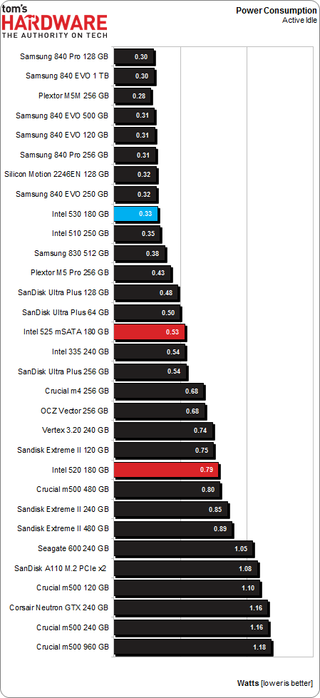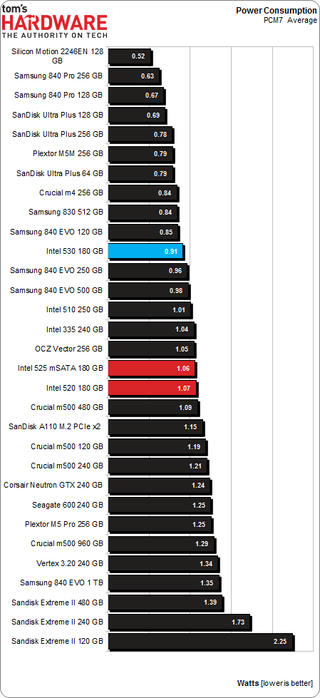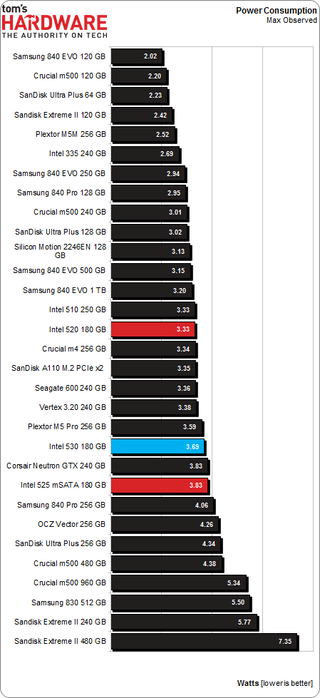Intel SSD 530 Review: A Revised Controller And 20 nm Flash
Intel recently lifted the veil on a replacement for its SSD 520, not surprisingly called the SSD 530. It partners new SandForce silicon with IMFT's 20 nm flash for better power consumption and a more modest price tag. Does the evolution pay off?
Results: Power Consumption
Idle Power Consumption
Idle consumption is the most important power metric for consumer and client SSDs. After all, solid-state drives complete host commands quickly, and then drop back down to idle. Aside from the occasional background garbage collection, a modern SSD spends most of its life doing very little. Enterprise-oriented drives are more frequently used at full tilt, making their idle power numbers far less relevant. But this just isn't the case on the desktop, where the demands of client and consumer computing leave most SSDs sitting on their hands for long stretches of time.
Active idle power numbers are critical, especially when it comes to their impact on mobile platforms. Idle means different things on different systems, though. Pretty much every drive we're testing is capable of one or more low-power states, up to and including DevSleep. That last feature is a part of the SATA 3.2 host specification. And while it requires a capable SSD and a compatible platform, enabling it takes power consumption down to a very small number. This is why we test active idle; it's easy to identify, and is still where SSDs spend most of their time.

One of the SSD 530's greatest selling points is lower power consumption at idle, which could have major implications on Haswell-based mobile platforms. SandForce's B02 controller is DevSleep-capable, so if we use a compatible system, it's possible to see deep sleep power consumption well under 1 mW.
Active idle isn't quite the same. Nevertheless, Intel's newer drive with its updated processor fares much better in this metric. The SSD 525 falls in between the miserly SSD 530 and more power-hungry 520.
PCMark 7 Average Power Consumption
If we log power consumption through a workload, even a relatively heavy one, we see that average use is still pretty close to the idle numbers. Max power may spike fiercely, but the usage seen during a PCMark 7 run is pretty light. You can see the drives fall back down to the idle "floor" between peaks of varying intensity.

Intel's three drives are the same size, feature comparable performance, and are close when it comes to power efficiency under load. That makes spotting differences at idle particularly easy. While the SSD 530, 525, and 520 trade blows at the high end, when it comes to logging PCMark 7, the newest model is clearly able to post the best power figures.
Stay on the Cutting Edge
Join the experts who read Tom's Hardware for the inside track on enthusiast PC tech news — and have for over 25 years. We'll send breaking news and in-depth reviews of CPUs, GPUs, AI, maker hardware and more straight to your inbox.

As a result, when we chart out averages, the SSD 530 looks most attractive. The SSD 520 and 525 are on roughly equal footing several spots down the hierarchy.
Maximum Observed Power Consumption
It's even better news for Intel that maximum power consumption isn't a critical specification for most desktop workloads. In the enterprise space, yes. This information goes into the calculation for total cost of ownership. But in a client environment, you shouldn't be seeing these numbers for more than short bursts.

When we measure observed consumption, the 20 nm-based SSD 530 splits the SSD 520 and 525, which employ 25 nm NAND.
Current page: Results: Power Consumption
Prev Page Results: File Copy Performance With Robocopy Next Page SSD 530 Offers Sassy Looks, Solid Performance, And So-So Pricing-
jimmysmitty I went with a 520 for the fact that Intel has some of the best reliability along with Samsung.Reply
As well we wont see much of a difference in performance until SATA Express (8Gb/16Gb) and even then we might not notice it.
The main benefit is lowering the price. If it sells for $170 that's a bit lower than $1/GB which is good since Intel is always a bit pricier than others. -
cryan Reply11835302 said:I went with a 520 for the fact that Intel has some of the best reliability along with Samsung.
As well we wont see much of a difference in performance until SATA Express (8Gb/16Gb) and even then we might not notice it.
The main benefit is lowering the price. If it sells for $170 that's a bit lower than $1/GB which is good since Intel is always a bit pricier than others.
I can't, in good conscience, recommend anyone actually buy the 180 GB 530 -- not when the retail boxed 240 GB is only $198.
Jay Crest (the 335) is a few bucks less, and its 240 GB edition is hovering near $180. Nice, but for just $20 more, grab the 530 240 GB box and call it a day... if for no other reason than the extra warranty coverage.
Regards,
Christopher Ryan
-
RealBeast I got a 480GB 520 a year ago on a great sale with the typical Intel rebate. Great drive. I'm hoping to see a nice rebate again this year as I need a number of drives.Reply -
diazalon Where i am the 840 pro is cheaper so i think i will just get that, seems to perform pretty well tooReply -
ssdpro The compressed vs incompressible data issue is still a problem for me with LSI/SandForce controllers. I need consistent data transfer and get that with my 840 Pro and Vector drives. With so many options I boil it down to 3 considerations: 1) Is data transfer consistent across data types and as fast as possible, 2) are there reasonable tools available from the manufacturer for examining drive condition, 3) how is the warranty and support in the event of the failure. The Intel 520/530 offering fails point 1 where Samsung 840 Pro and OCZ Vector excel. Intel, Samsung, and OCZ pass point 2. OCZ wins point 3 easily. They have active support forums and mostly reasonable support staff. Intel has decent process, OCZ has decent process. Samsung has horrid and lengthy support procedures. If you visit Samsung.com to initiate a support request I bet you can't even find your Evo or Pro on the drop down menu you MUST use. You have to call and wait on hold endlessly.Reply -
vertexx Thanks for the informative article - would have liked to see a couple different capacities tested.Reply
If you look at the number of models and form-factors available for the 530, I'd say this product line is primarily about one thing: Distribution.
The price points for the 240-256GB capacity drives have come down enough where they're probably ready for the mainstream. You see this with Samsung's aggressive (and cheesy) marketing of it's EVO line to the mass consumer market, and this is Intel's attempt to achieve maximum penetration into that market.
About two months ago, I refreshed my 2-year-old primary work laptop with the Intel 335 240GB. It was on a special at Newegg for $50 off at $170. Now that same drive lists for $180. For a work PC, I was waiting for SSD affordability in the 240-256GB range before pulling the trigger, as anything less would lead to too much hassle moving files around between drives. So, I upgraded from a single 500GB HDD that was getting slower by the day to a 240GB SSD for my primary and a new 750GB secondary HDD running in a caddy in the ODD bay. With this upgrade, I believe I'm set for the next couple of years with this laptop, given the lower pace of development for core CPU tech.
Overall I'd say that the 530 performance numbers in this article are disappointing, although low power consumption certainly is valuable for the laptop market. Still, I think the market expects performance improvement along with power efficiency improvement, even though reality is you probably wouldn't notice the difference in everyday use.
It would have been good to see the performance numbers for the 240GB drive, as that really is the minimum point where you could reasonably get away with running a SSD as your sole system drive. With the prices coming down at that capacity, there certainly is a point in marketing SSD affordability in the mainstream segment.
The other main selling point for me was reliability. Samsung leads the pack here with Intel not far behind. I passed over the Sandisk Ultra Plus 256GB recommended in Tom's "Best SSD's for the $$" due to a high percentage of 1-star ratings on Newegg and only 2-year warranty. It came down to the 335 and the 840 Evo, with the Evo having slightly better performance and the 335 at that point being about $30 cheaper with the Newegg Promo. I went with the lower price and the rest is history.
For those contemplating upgrading to a consumer grade SSD, don't sweat the minor performance differences. Go with a good brand and a line with good reliability ratings. Do the hard work of re-installing a fresh copy of Windows (instead of using a migration utility), and your system will be flying. I couldn't be happier with this upgrade.
-
npyrhone I think this is the least exciting SSD release this year. I really challenge you to find a major SSD release this year that showed less. 530 is relatively expensive and on the slow side. It excels in nothing.Reply
Intel's post x-25 SSDs' only claim for fame is "reliability" which is nothing but a mantra. Intel's SSD are no more or less reliable than any other manufacturer's. They do give a five-year warranty, true, but it means nothing. They break down just as often as others do, and because of this, Intel pays a bit more by sending replacement drives. This is small potatoes, a minute cost to pay to be considered "more reliable" by those less informed. Especially since the warranty does not cover all the hassle and expenses that come from actually replacing the broken drive (you must stop working, start waiting, install the new drive, move all the data, etc). Of course its nice to live in the beautiful illusion that by buying an Intel SSD I am more safe from all this.
I would never buy this over a Samsung-product that is less expensive, has greater performance and equal reliability. I can't understand why this article concludes like it does. It should say: "There is nothing wrong with 530, but you can get better for cheaper, so stay away from 530." -
cryan The 530 and the newly announced 1500 Pro are both about filling out the gaps in client computing. Both are nearly identical, with wide varieties of form factors and capacity points.Reply
Regards,
Christopher Ryan
-
npyrhone Cristopher: Is there a single metric that would support the decision for anyone to fill that gap with an Intel 530 product, rather than with a Sandisk Ultra Plus product, or Samsung 830 840 (EVO) product?Reply
Most Popular

